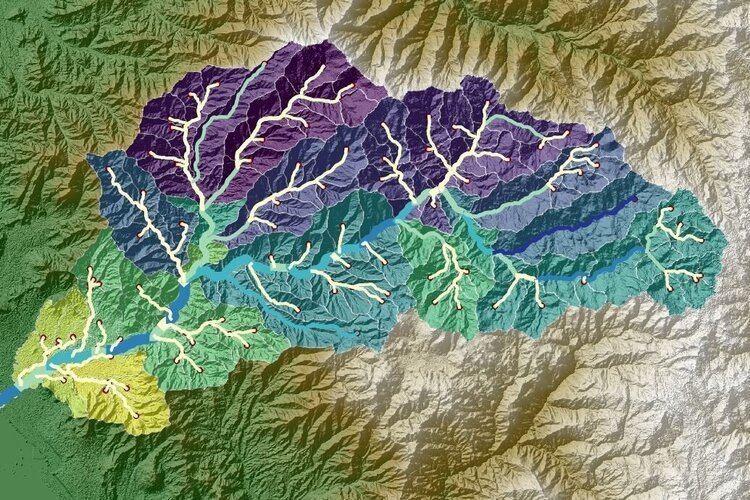Geospatial Crop Recognition from Drone Orthophotos with Python and HatariTools - Tutorial
/Spatial analysis and machine learning sometimes require massive coding in order to achieve decent results such as identifying plants from a drone orthophoto. We wanted to create a simple workflow for beginner and intermediate Python users to work with these libraries without much pain or frustration. This tutorial has the complete procedure to use a new Python package called hatariTools that recognizes plants from an orthophoto based on sample points and creates intermediate plots and identifies plants as point shapefiles.
In order to improve the accuracy of the crop detection you have to:
Take the orthophoto with the minimum amount of shadows, that means at noon.
Select regular plants and give enough space for land to define its complete shape.
Avoid plants that cross each other
You can install the latest version of hatariTools with:
pip install -U hatariToolsTutorial
Code
from hatariTools.geospatialIA.cropRecognition import cropCounting ## Org
import matplotlib.pyplot as plt ## Org# Create crop object
crop = cropCounting() ## OrgFollow us: |
|
|
|
|
|
|
/-------------------------------------------/
The crop recognition engine has been started
/-------------------------------------------/# Define raster and sample plants
crop.defineRaster('../odm_orthophoto/agaveCropCoarseClip.tif') ## Org/-------------------------------------------/
CRS of Raster Data: EPSG:4326
Number of Raster Bands: 3
Interpretation of Raster Bands: (<ColorInterp.red: 3>, <ColorInterp.green: 4>, <ColorInterp.blue: 5>)
Raster unit is unknown and resolution is 0.00
/-------------------------------------------/crop.definePoints('../shp/agavePoints_7p.shp') ## OrgCRS of Point Data:EPSG:4326# get point coordinates
crop.pointCoords ## Org[(-104.6026805707282, 21.488557889609346),
(-104.60290182768277, 21.488567022907),
(-104.60275177934567, 21.488441340921597),
(-104.60272718507797, 21.488446712083505),
(-104.60284817756734, 21.488475377126544),
(-104.6029300358111, 21.488499605292862),
(-104.60288397972741, 21.488506464709577),
(-104.60267744841107, 21.4884550248774),
(-104.60267523760433, 21.48846104318461),
(-104.6026923713565, 21.488474000968505),
(-104.60271024204422, 21.488489476615623),
(-104.6026697105875, 21.4884743694363)]#aprox cell diameter = 2.5m, get cell radius in meters
cellRad = int(0.00001/2//crop.rasterRes) ## Org
print(cellRad) ## Org19# ratio of analysis
crop.pointRatio = 35 ## Org
# raster band for the match template analysis
crop.selectedBand = 0.2125 * crop.redBand + 0.7154 * crop.greenBand \
+ 0.0721 * crop.blueBand ## Org
# sample row, col and array for each point
crop.getPointRowCol() ## OrgPoint N°:0 corresponds to row, col: 368, 1116
Point N°:1 corresponds to row, col: 331, 231
Point N°:2 corresponds to row, col: 834, 832
Point N°:3 corresponds to row, col: 812, 930
Point N°:4 corresponds to row, col: 698, 446
Point N°:5 corresponds to row, col: 601, 119
Point N°:6 corresponds to row, col: 573, 303
Point N°:7 corresponds to row, col: 779, 1129
Point N°:8 corresponds to row, col: 755, 1138
Point N°:9 corresponds to row, col: 703, 1069
Point N°:10 corresponds to row, col: 641, 998
Point N°:11 corresponds to row, col: 702, 1160# plant arrays
crop.plotReferenceImages() ## Org# define object order and output raster path
#matchTemplate = crop.singleMatchTemplate(1,'../rst/matchTemplate.tif')# plot match template
#plt.imshow(matchTemplate)#plot histogram to check theshold values
crop.singleMatchHistogram(1, interval=[0.20,0.30]) ## Org# define method (quantile or threshold) and value
crop.pointsMatchTemplate('threshold',0.25) ## OrgProcessing image Nº 0
Processing image Nº 1
Processing image Nº 2
Processing image Nº 3
Processing image Nº 4
Processing image Nº 5
Processing image Nº 6
Processing image Nº 7
Processing image Nº 8
Processing image Nº 9
Processing image Nº 10
Processing image Nº 11#working with all points => takes time
# plot all templates
# crop.plotAllTemp/lates()
# save match template to a shapefile
#crop.saveMatchShp('../outShp/matchCrop.shp', limit=10000)# Birch clustering
crop.birchFilter() ## Org# plot birch points
crop.plotBirchPoints() ## Org# save cluster points as shapefile
crop.saveBirchShp('../outShp/birchCrop.shp') ## OrgInput file
You can download the input files from this link.




























